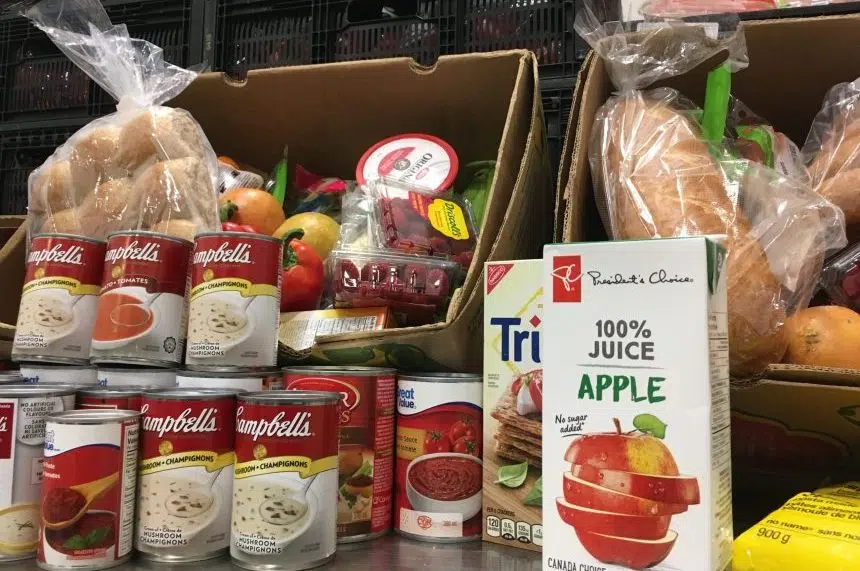As many households struggle with mounting costs for necessities like food, rent and gas, the place where many turn when they can’t manage alone is also hurting.
Saskatoon Food Bank and Learning Centre executive director Laurie O’Connor said about 20,000 people used its services in May — everyone from families to students to newcomers. That was an increase in need that O’Connor said was back up into the pre-pandemic range.
Rising costs from inflation since January have meant a steady increase in people using the Saskatoon Food Bank over the past six months.
O’Connor said staff with the food bank’s emergency food program had their busiest day so far of the year on Monday, serving around 1,200 people with 400 hampers.
O’Connor said inflation is affecting the people who need services and the food bank’s own ability to purchase food for hampers.
Those hampers are costing more too, and it can be difficult to ensure those are filled for the people who need them.
Part of the problem is fewer donations, coupled with major supply chain issues.
“The cost of food is up. We’re struggling to get food in the door,” O’Connor said. “Certainly we’re seeing far less food through the door for the money that we’re spending on that.”
She said Saskatoon offers great support to the food bank, but has noticed people are “definitely donating less.”
“Unless we’re making a concerted effort and pitch out there, we know we’ll be struggling,” O’Connor said, noting the food bank is gearing up for a busy summer while anticipating a slump in donations.
John Bailey, the CEO of the Regina Food Bank, said staff try to be strategic with their food purchases, like buying in bulk when prices on a certain item are more reasonable.
“We know our food costs are significantly up,” Bailey said, noting changing purchasing patterns helps the food bank buy enough food and manage how much it’s spending at the same time.
Bailey said the ability to do that might actually mean food banks are at less of a disadvantage countering the cost of inflation than the average household, which would lean more towards buying what they need when they need it.
The tactic does affect the food bank’s budget and variety of food purchases, Bailey noted.
The food bank doesn’t have as much control when it comes to gas prices, though. Bailey said it makes about 100 deliveries a day in Regina.
“We have no purchasing power on fuel so the fact that gas is about 80 cents more a litre than it was a year or so ago, that’s having quite a significant impact on us,” he said.
He said staff have to take time to plan their routes to try and optimize fuel efficiency as a means of keeping fuel costs as low as possible.
“It’s really taken a bite out of our operations,” Bailey shared.
Also increasing is the dollar value per food hamper the food bank puts together. He said the value has gone up, maintaining the same size and assortment of what each basket provides.
When that’s for 320 food hampers a day, Bailey said: “That’s really significant dollars in terms of how much we’re spending on food.”
It’s the second consecutive year Bailey said the food bank expects to be around a half-million dollars worth of purchased food — including various discounts and partnerships that help the food bank keep costs more manageable.
Adding to that is that more people are “absolutely” needing to access services than there have been in the past. Bailey said the food bank’s 320 hampers each day used to total 295 about this time last year.
Many of those baskets being given out are going to people who Bailey said have never needed to turn to the food bank before. Staff also are seeing people need assistance more frequently than in the past, with people who are “on the precipice of food insecurity … It’s pushing them to need our support.”
He anticipated a trying summer, with steady or heightening demand and fewer donations, similar to Saskatoon.
“We’re not in a crisis situation,” Bailey said, though he said the food bank also has seen a decrease in donations.
“We anticipate that this will be another one and a new set of challenges as we try to make sure we’re meeting this unprecedented level of demand.”
“I think the cost of food, gas (and) housing has taken a tremendous toll on the entire city and really nobody has the ability to have more money in their pockets,” O’Connor added.
The Saskatoon Food Bank appreciates donations of cash and food. Bailey said cash donations and volunteers are their greatest needs.
— With files from 980 CJME’s Lisa Schick







